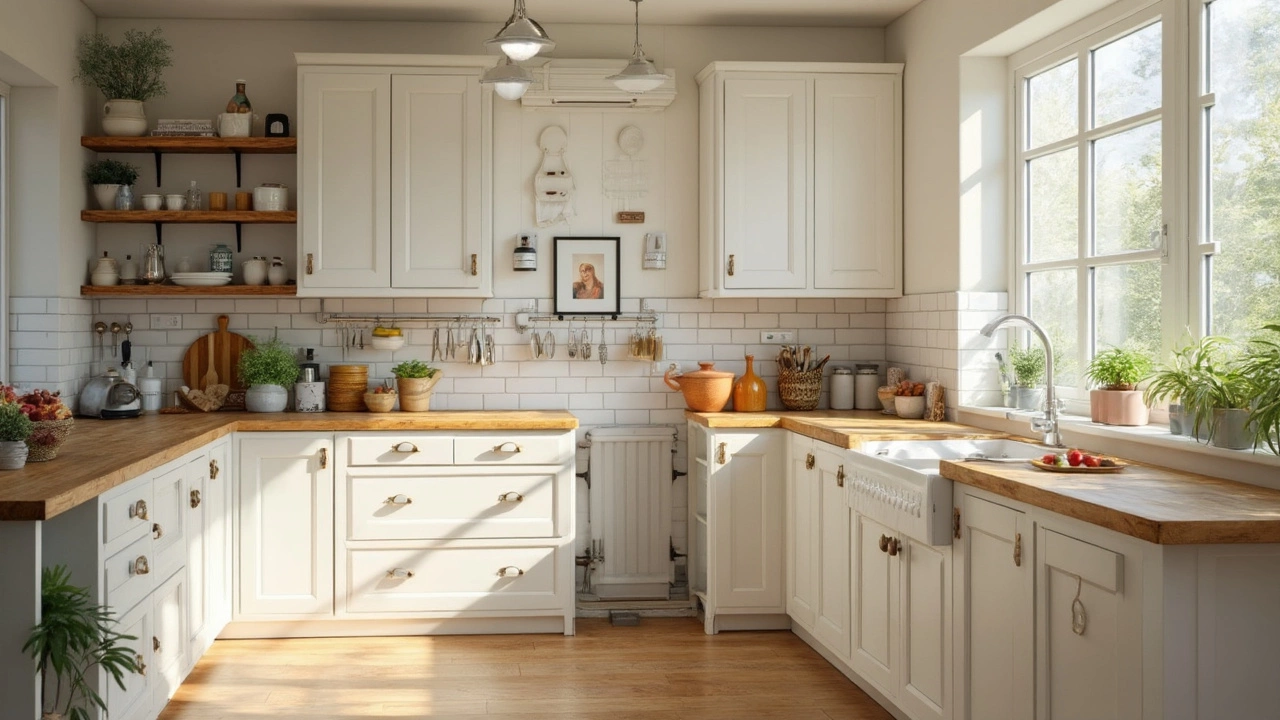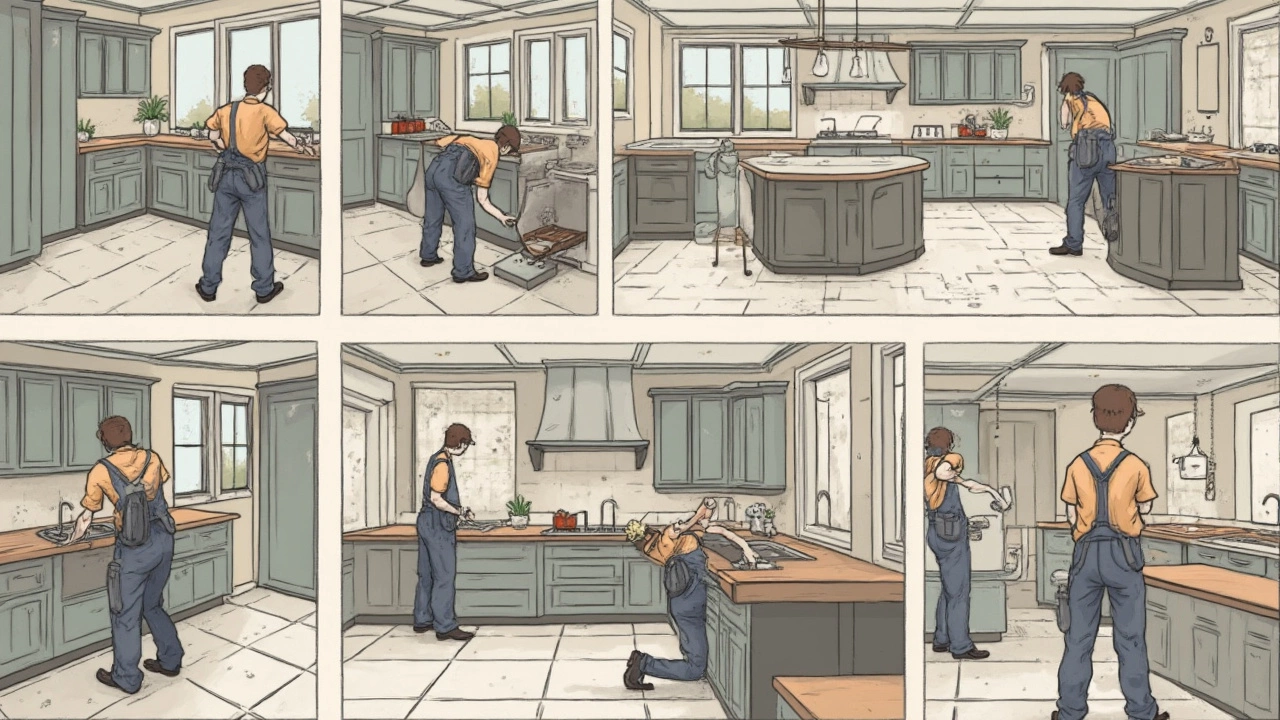Kitchen Installation: What's Included?
 Mar, 11 2025
Mar, 11 2025
Ever wondered what goes into getting your kitchen up and running? It's more than just throwing in some cabinets and calling it a day. A full kitchen installation involves several steps, each one crucial to making sure things don't just look good, but work well too. Let's break it down.
First off, you've got cabinetry. This isn't just about storage, it's about setting the vibe for your space. Pro tip: Before you even start, think about your lifestyle. Are you a family that cooks a lot? You might need more storage. Cabinets also provide the framework for how the rest of your kitchen will come together.
Next, those countertops and surfaces. They're where the magic happens – from breakfast on the go to masterchef-worthy dinners. When choosing materials, consider durability and the kind of maintenance each type might need. Some materials are tougher and can handle spills better, while others might require more TLC.
Cabinetry Essentials
When it comes to kitchen installation, kitchen cabinetry is the backbone of your setup. It's not just about where you'll tuck away your pots and pans, but how you'll define the flow and functionality of the space. Let's break down the essentials.
Choosing the Right Material
Your cabinets need to stand the test of time, both in terms of style and durability. Common materials include solid wood, MDF (Medium-Density Fiberboard), and plywood. Solid wood is a classic choice, cherished for its strength and beauty, but it can be pricey. MDF offers a budget-friendly alternative, known for its smooth surface, ideal for paint.
Configuration and Layout
Getting the layout right is key. Start by asking yourself some questions: Do you have enough room for an island or do you need more wall cabinets? Think about accessibility too—are you placing essential items at a reachable height? A well-planned layout streamlines cooking and cleaning, making sure everything you need is within arm's reach.
Style and Finish
Here’s where you can really make your kitchen pop. Whether you’re into a modern sleek look with high gloss finishes, or prefer a more traditional woodgrain appearance, your choice of finish will set the tone. And don’t forget about the hardware—handles and knobs might seem minor, but they can significantly impact the overall look.
Smart Storage Solutions
Maximizing storage is crucial, especially in smaller spaces. Consider incorporating features like pull-out spice racks, lazy Susans, or deep drawers for pots. These additions not only save space but make sure you're not left rummaging around while trying to whip up a meal.
| Material | Durability | Cost |
|---|---|---|
| Solid Wood | High | High |
| MDF | Medium | Low |
| Plywood | High | Medium |
Remember, kitchen installation isn't just about tossing in some shelves. It's about building a space that works for you, day in and day out. Make choices aligned with your needs and lifestyle for a kitchen that not only looks great but works like a charm.
Countertops and Surfaces
When it comes to kitchen installation, the choice of countertops is one of the most fun—and sometimes tricky—decisions you'll make. After all, these surfaces need to be durable and look good since they're where you prep, cook, and even eat.
Granite and quartz are two of the most popular choices these days, and for good reason. Granite is known for its durability and natural beauty. This stone can handle heat like a champ, but you’ll need to seal it periodically to avoid stains. Quartz, on the other hand, is an engineered stone, making it less prone to chipping and requires less maintenance while offering a wide variety of looks.
Budget-Friendly Options
If you're keeping an eye on the budget, laminate and solid surface materials offer great looks without breaking the bank. Modern laminates mimic the look of stone and wood so well; your friends might not even spot the difference!
Wood countertops, like butcher blocks, bring warmth to a kitchen. They're great for chopping and cutting, but they do need a bit of TLC to stay looking good. Regular oiling should do the trick to keep them sealed and stain-free.
Things to Consider
- Functionality: Think about what you need. Do you chop a lot? Maybe go for something more durable like quartz.
- Aesthetic: Match your countertop material with the rest of your kitchen style.
- Maintenance: Some materials require more upkeep than others, so consider how much work you're willing to put in.
| Material | Pros | Cons |
|---|---|---|
| Granite | Durable, heat-resistant | Requires sealing |
| Quartz | Low maintenance, variety of styles | Can be pricey |
| Laminate | Affordable, versatile looks | Not as durable as stone |
| Wood | Warm, great for cutting | Needs regular oiling |
Choosing the right countertop isn't just about looks; it's about getting a surface that fits how you use your kitchen. With so many options out there, you're bound to find something that meets your needs and matches your style.

Appliance Integration
When it comes to transforming your kitchen into a functional hub, appliance integration is where the rubber meets the road. This step is all about fitting everything seamlessly into your kitchen space without sacrificing aesthetics. So what's involved?
Choosing the Right Appliances
First, pick your appliances carefully. Think about how often you use your oven or if you really need that built-in espresso machine. Not all kitchens need the same gadgets, so choose what works for you. Ensure your appliances fit the design and layout you've dreamed up – last thing you want is an enormous fridge in a tiny kitchen.
Planning the Layout
Proper planning is crucial. The triangle layout remains popular, where the fridge, stove, and sink form a triangle. It's ergonomic and efficient but doesn't work for everyone. Tailor your layout based on how you move around your kitchen. Or if you prefer to have your hardware more spread out across various surfaces.
Seamless Installation
During installation, professional help can be a lifesaver. Ensuring appliances are properly installed means fewer headaches down the line. Wondering why your dishwasher's making funny noises? Could be a sign of incorrect setup. Investing in skilled installers can prevent such hiccups.
Aesthetics Meet Functionality
Appliances need to look like they belong. Integrated designs where they blend into cabinetry are popular, especially for a sleek, modern look. Remember, though, functionality is just as important. That ultra-modern flat cooktop might look fantastic, but if you love a good stir-fry, a gas range might suit you better.
Here's a quick comparison:
| Appliance | Average Lifespan (years) |
|---|---|
| Refrigerator | 14-17 |
| Oven | 13-15 |
| Dishwasher | 9-12 |
| Microwave | 9-10 |
Keep these lifespans in mind to plan budget-friendly upgrades down the line. This helps avoid unforeseen expenses and ensures your kitchen stays up-to-date.
Plumbing and Electrical Setup
When it comes to kitchen installation, plumbing and electrical work are like the backbone of your setup. Without these essentials done right, you could end up with a fancy kitchen that doesn't function! Let's see what's involved.
Getting the Plumbing Right
Plumbing in a kitchen isn't just about connecting taps. It's about ensuring there's an efficient water supply and drainage system. You'll usually find key elements like sinks, dishwashers, and sometimes fridges that need to be connected to your home's water lines.
- Sinks: Most kitchens have more than one basin nowadays, which requires precise plumbing for each.
- Dishwashers: These need a dedicated water line and should be positioned close to the sink to avoid a mess.
- Fridges: If you've got a fridge with a water dispenser or ice maker, it'll need a water line too.
It's crucial to hire qualified plumbers to ensure everything is installed correctly to avoid leaks or worse, floods!
Wiring It Up
Just as important, and sometimes more complicated, is the electrical setup. It powers all those shiny appliances, from your fridge and microwave to the less glamorous but equally essential range hood.
- Outlets: Make sure you have enough outlet space. You’ll need several near your work surfaces for gadgets like toasters and blenders.
- Lighting: Good lighting can make or break your kitchen experience. Under-cabinet lighting not only looks cool but also makes food prep easier.
- Appliances: Ensure that high-power appliances like ovens and refrigerators are on separate circuits.
Did you know? A typical modern kitchen has 3 to 4 dedicated circuits just for appliances!
Electricians play a huge role, and just like with plumbing, it’s essential to hire certified professionals. Faulty installations can be dangerous.
So, next time you plan a kitchen renovation, keep in mind the nitty-gritty of plumbing and electrical setup. They’re what makes the kitchen tick, often unnoticed until they go wrong!
